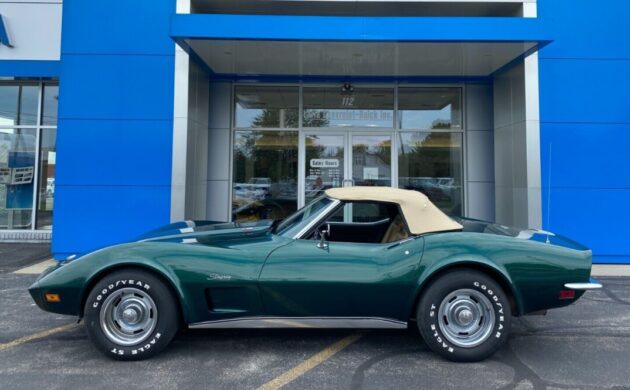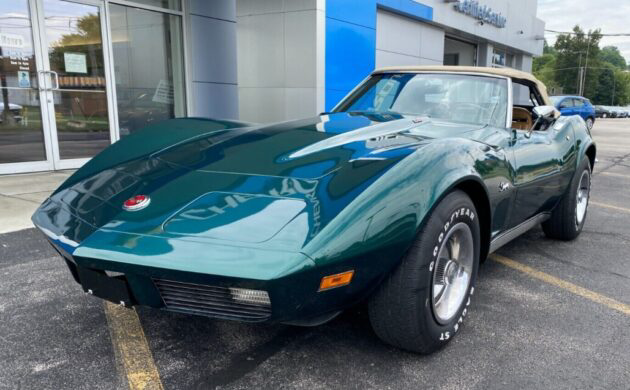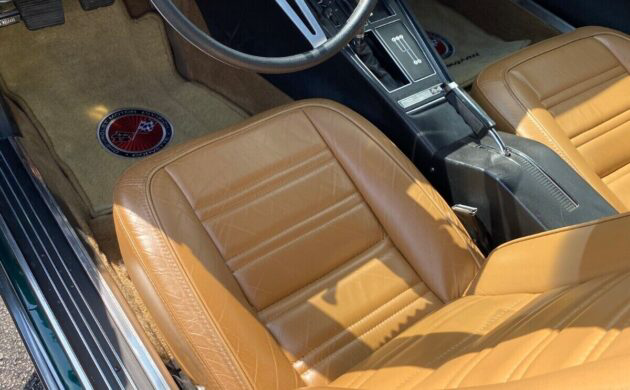By 1973, buyers faced fewer choices if they felt the entry-level engine didn’t provide the desired performance in their new Corvette. They could opt for a big-block, although the slightly more expensive L82 small-block proved a more popular choice. That is what we find with our feature Convertible, and its overall condition adds to its appeal. It needs a new home, so it is listed here on eBay. The ‘Vette is located in Rittman, Ohio, and while it hasn’t reached the reserve, spirited bidding has pushed the price to $25,100.
Chevrolet offered Corvette buyers in 1973 a selection of ten paint shades. The original owner of this classic chose Code 945 Blue-Green. It shines impressively, although it is unclear whether the vehicle has received any form of prior restoration work. I can’t spot any significant flaws in the paint or fiberglass, while the car comes with a nice soft-top and a factory hardtop clad in Black vinyl. We receive some excellent underside shots that paint a positive picture. There is no evidence of rust or other problems, and the fact the seller encourages in-person inspections suggests they have nothing to hide. The glass and trim are excellent, while the Rally wheels, trim rings, and center caps are spotless.
Disappointingly, we receive no engine photos, but that brings us to a fascinating aspect of the 1973 Corvette story. The base engine for that model year was the L48 version of the 350ci V8. It pumped out 190hp and, when teamed with a four-speed manual transmission, allowed the car to produce a sub-16-second ¼-mile ET. If that wasn’t enough to satisfy potential buyers, they could select the L82 version of the small-block or the LS4 big-block. The latter was the cheaper of the two, adding $250 to the sticker price. It also lifted power and torque to 275hp and 390 ft/lbs. However, some buyers saw it as less desirable because it added 212lbs to the car’s weight, with it all over the front wheels. That characteristic made the Corvette less agile and may explain why only 4,412 buyers ticked that box. The L82 cost its buyer $299, and while more expensive, it added nothing to the Corvette’s weight. It proved the weapon of choice for 5,710 buyers. That is the path the original owner selected with this classic, teaming the L82 with a four-speed manual transmission and power steering. With 250hp available under the right foot, the ¼-mile ET dropped to a respectable 15.1 seconds. The seller provides no information on how the ‘Vette runs or drives. They mention an odometer reading of 69,595 miles, but not whether they believe that figure to be genuine. Once again, an in-person inspection may bring potential buyers closer to the truth on that question.
The Corvette’s interior is tidy and has no pressing needs, but it isn’t 100% original. The seats wear Medium Saddle leather covers, which are a later addition. The Tag shows Code 400, which is Black vinyl. The door trims retain that material, but I think someone also changed the carpet to match the seats. Otherwise, the interior is unmolested and needs nothing. The plastic is in good order, the gauges feature clear lenses and crisp markings, and there is no appreciable wear. It isn’t loaded with optional extras, but the factory AM/FM radio and the tilt/telescopic wheel are desirable additions.
The 1973 model year was one of significant changes for the C3 Corvette. It saw the chrome front bumper disappear, engine power and performance dropped as the company grappled with tightening emission regulations, and Chevrolet changed the suspension tuning to improve refinement. Typically, such changes would negatively impact sales, but the opposite proved the case. Volumes increased by 11% compared to the previous year and continued to climb throughout the 1970s. Classic buyers spent years ignoring these cars in favor of the chrome-bumper models, but the thirty-seven bids submitted on this Convertible demonstrate that the worm has turned. Recent sales results suggest that the bidding may have to top $30,000 before it meets the reserve. Given the action so far, I suspect that will happen. Do you agree?





Once the original LT1 disappeared at the end of ‘72, the L82 was the hot ticket for the C3. Big blocks ruined the handling.
Like the writers on Barnfinds who continually insist that big blocks effect a Corvette’s handling, you’re also wrong about their handling. Corvette engines are mounted behind the crossmember, and lower in the frame, then in the average car. As a result, big block Corvettes have a near perfect 51/49 weight balance (small blocks average 49/51). Big blocks handle just as well as any small block.
I’ve been crewing for Corvette race teams since the 70’s. First on autocross cars, then in SCCA club racing and eventually Trans Am. The last 15 years I’ve crewed for a team that vintage races both small block & big block Corvettes.
Put Aluminum heads and intake to loose the weight.
Does it have the birdcage?
This looks like it’s been really taken care of so someone’s going to pay the price for something nice!
My brother just bought a 73 convertible it’s beautiful, but I really like this one better
The 73 is the last year that I would even consider, I never liked the rear bumper covers from 74 on. I like the saddle color seats, but without saddle door panels and other matching parts it just looks wrong to me. Other than that, I like it!
Yeah, I’m totally with you guys. Carroll Shelby also completely RUINED the Cobra when he dropped in the 427. The 260’s handled like dreams. The 289’s were essentially the same engine, so no big. But, the writing was on the wall. He didn’t even bother with the 352 or the 406. He just went all out cubes (like you’d think there were no substitute for cubic inches or something?), and just destroyed the handling. So much so, that 427 Cobras could barely eke out 4 straight SCCA A/Production national championships from 1966 to 1969.
I’ve owned 3 big block Corvettes. A 1965 Convertible, a 1969 427 3X2 4-speed A/C Convertible and an identical spec 1968. All were magnificent.
Sure, I might have been able to fabricate a way to stuff a Vega all-aluminum 4 in the engine room to make the pipe-smoking, leather patches on the elbows crowd happy, and soak up some more magical handling, but… REALLY?
I not only had iron big blocks/heads, but added another 80-ish pounds for air conditioning (except the 396). The handling was spectacular (by late ’60’s standards).
In 1980, I had about $10-15K into my first (1969) Tri-Power. I raced a 2-3-year-old turbo-Porsche and blew his doors off. By the way, and to be fair, he did make up some ground in the corners. He had a little over $45,000 in his Schnitzel-mobile. I told him, give me the extra $30,000 to put into my Corvette, and he’d need to put $100,000 more into his, in order to keep the Vette in sight.
Whenever I read people saying how large engines are no good, especially on the street, I just think of Prairie Dog Town; everyone poking their heads up, looking around, spouting the conventional line (I just couldn’t write ‘wisdom’), then back to their holes.
Were Corvettes 10/10ths race cars? No. They were superb street machines. Big Blocks were the top of the heap. Head and shoulders above Mustangs, Camaros, and even most foreign exotics. Could I have raced them? Sure. With enough money and work. But these were DRIVERS, and as Teri Hatcher so famously said;
“They are spectacular!”
I wonder how many of the sales managers are bidding on this to run the price up?
Stop me if you have heard this before, but when I was welding at the Electric Boat shipyard in Groton, CT, in 1973, I had an apartment in Mystic, CT. The gentlemen who owned Seaport Canvas, a sailmaking shop in Mystic had the twin to this Corvette parked in front of his shop everyday until winter set in. I’m pretty sure that car was the one that set me on the path to Corvette ownership. It just looked great, as does this one. Good luck to all.
“However, some buyers saw it as less desirable because it added 212lbs to the car’s weight, with it all over the front wheels. That characteristic made the Corvette less agile and may explain why only 4,412 buyers ticked that box.”
Look at the side-view image again. if what you say is correct, the radiator and fan should be sticking out in front of the bumper. The engine, whether a 454 or 350 was not “all over the front wheels” The center of gravity of the engine was about a foot and a half from the centerline of the front wheel.
Thank you Mr. Sumatra & gbvette62.
Would have included that and a lot more, but my rant (er… comment) was turning into a booklet, or at least a long magazine article.
I could include another tidbit: The NHRA used the weight distribution angle as their excuse to discriminate against Corvettes throughout the ’60’s & partway through the ’70’s, making them run in their own class, instead of heads up with Camaros, Mustangs and the like. By the time Mr. Parks had blessed the Corvette owner with equality, drag racing was in such a sorry state that nobody really cared.
@RC- If you remember the great road test articles by the Road and Track magazine folks during the glory days, I have a copy of the June 1973 Corvette LT-1 test. You may remember the scaled outline drawing of the test car that accompanied each test data page. The drawing quite clearly shows the center of the engine about 20″ from the center of the front wheel. I enjoyed your comment and gbvette62 knows his business.
Frank Sumatra – There are many ‘bench racers’ / people who can’t refrain from expressing opinions for which they have no experience, (but have read enough to make them think they know what they are talking about). Yes, in the ’60’s and ’70’s I couldn’t wait for my copy of Road & Track and Car & Driver each month (and Hot Rod, Car Craft, Car Toonz, Cycle Toonz, and many others). I could stare at those “cutaway” drawings for hours. As you know, I am full of stories from “the day”, and enjoy sharing from time to time. Maybe one day, I’ll tell the story of how I began to buy, fix up and sell some of the most desirable muscle cars.
Thank you for remarking.
This is a fairly rare car being an L-82 AND a 4-speed. The icing on the cake would be if it had factory air. Those cars are highly sought after now in 1973s and 74s, especially if they are convertibles.
BTW, the ’73 and ’74 Corvettes did not come with L-82 emblems on their hoods.
Please excuse the typo- “L-82” not “LT-1”. Thank you.
Finally some positive comments about the 73, a one year only design. I wanted one since the Oct 1972 Road and Track about a silver on black L82 coupe with YJ8 wheels of which four cars reportedly got before poristy problems came to light. Garbage made in Mexico. Anyway, I iown a twin to that very car and it is superior to the 71 454 coupe I had in the 70s. L82 is a great engine with forged internals and no hassle hydraulic cam.
Yes, All C3’s have a “birdcage”. Photo from a Corvette Forum.
It’s so nice to see a birdcage in great condition. These LOVE to rot out from the top of the windshield frame on down, and also at the front bottom where the rectangular hole is and at the base of the rear section. I found out the hard way.
Still better to deal with than the rot you see in old Mopars, etc.
Absolutely right!
So far nobody comes and drops a LB-6 (2.8L GM crap with !130hp)
to get rid of the big block to convert into a economy box for the
new electric age, im fine with it.
Somebody called GM is planning on an all-electric Corvette in the next five years. A hybrid model has been announced for 2023.
If it is as stunningly (un)successful as the Volt, I guess this is the end of the line for Corvette. Where is Zora when you need him? Sigh.
@RC-I think it is a perfect time for a hybrid or all-electric Corvette. They are the high-performance cars of the very- near future.
@RC Graham
The Volt was the right car at the wrong time. It was good in a lot of ways but it was terribly overpriced and people just didn’t give it much of a chance.
GM plans to be all electric by 2035. And I read yesterday that the Dodge Challenger and Charger will cease production after 2023 only to be replaced by some type of electric vehicle, and no, not just electric versions of those same cars.